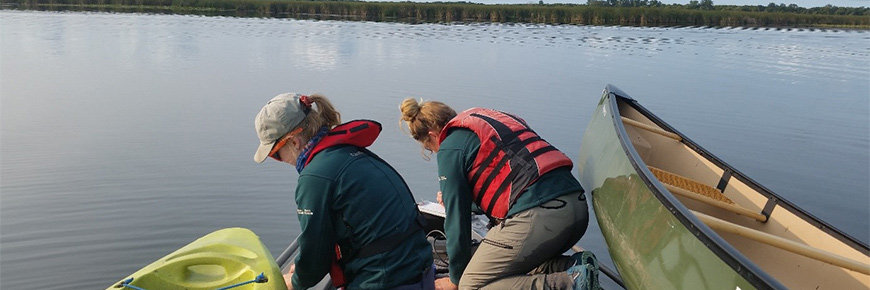
What is being done to restore the health of the marsh?
Point Pelee National Park
Recognizing the threats posed to the marsh, park staff held a workshop, bringing together a total of 30 knowledge holders, practitioners, experts, and learners with representatives from Parks Canada, Caldwell First Nation, Bkejwanong-Walpole Island First Nation, Canadian Wildlife Service, Environment and Climate Change Canada, Ontario Ministry of Natural Resources and Forestry, Bird Studies Canada, Essex Region Conservation Authority, University of Windsor, University of Waterloo, University of Toronto, Invasive Phragmites Control Centre, and University of New Brunswick. Threats, conservation strategies, and the possible steps forward were discussed. This workshop was the first of many consultations over the following years that guided the development of the Marsh Restoration Project.
Over the next few years, Parks Canada staff will conduct invasive cattails and Phragmites management in the marsh with the goal of restoring the diversity of open water and edge-water habitats. Staff plan to create approximately 8 hectares of ponds and channels, and undertake targeted removal of invasive species within areas of concern.
How will it be done?
Different areas of the marsh pose different challenges, requiring a combination of management techniques.
- Applying herbicide
Herbicide will be applied to invasive Phragmites growing on land within target locations. Using a combination of hand-wicking and backpack spraying, the herbicide will be applied directly to green foliage. The use of herbicide is carefully controlled and follows all regulations, prescribed safety protocols, and mitigation measures for both people and wildlife. For example, species at risk are flagged and avoided to ensure their protection. - Cutting under the water line
In target locations where Phragmites are rooted in water, staff will cut the stems under the water line to drown the plants. Using hedge trimmers, hand tools, and an amphibious cutting machine, the stems will be cut far enough under water that their oxygen will be depleted before new shoots can reach the surface. Cut Phragmites stems will be piled, and piles will either be left as potential habitat mounds for wildlife which will break down and compact over time, or removed with prescribed fire. - Mechanically creating channels and ponds
The creation of channels and ponds within the invasive cattail mat will be completed by a pair of aquatic machines: an aquatic vegetation cutter and an aquatic weed harvester.
Meet the aquatic machines
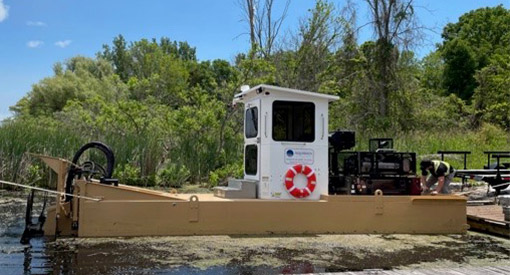
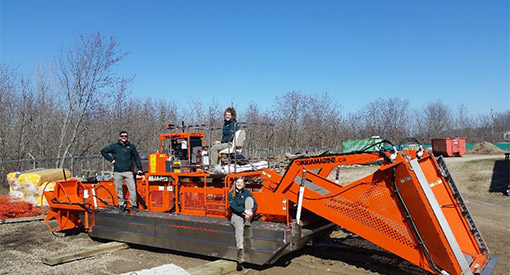
To create more open water habitat, Point Pelee National Park staff will use two aquatic machines. The Aquatic Vegetation Cutter will carve through the cattail mat, and break up the dense organic matter from which the cattails grow.
Once enough area has been cleared by the vegetation cutter, the Aquatic Weed Harvester will collect the cut material and pile it in pre-approved locations on the edge of the cattail mat, thereby creating habitat mounds. Some of these mounds will be come habitat. They will be placed beside open water to act as areas for nesting and basking and eventually breakdown to provide the ground material from which new flora can grow. Other mounds will be burned by trained staff when environmental conditions are suitable to ensure there is not an excess of piled plant material (or biomass).
What precautions will be taken to avoid disturbing wildlife?
Park staff are dedicated to the health and conservation of wildlife including species at risk. Measures are in place to reduce the impact of the machines on wildlife as much as possible, including:
- Scheduling work outside of peak bird breeding season, fish spawning season, and turtle hibernation.
- Conducting surveys before operating machinery in an area to monitor for the presence of wildlife.
- Placing turbidity curtains in the water around the work area to decrease soil disturbance and turned up materials in surrounding areas.
- Performing several ‘false starts’ with the machines to create noise to temporarily drive away wildlife in the area.
When and where will work be done?

Phase 1: Surveys
Before restoration begins in an area, it must be surveyed. Aerial and ground surveys will record the species present, characteristics of the site, and examine the feasibility of using equipment in targeted places. Each year, this phase will give us a detailed idea of what to expect in these areas.
Phase 2: Monitoring
Before, during, and after active management takes place each year, staff monitor the effects of these activities on the marsh. Ecological indicators such as water quality and species presence informs staff of the impact restoration actions are having on the health of the marsh ecosystem.
Monitoring projects in the marsh
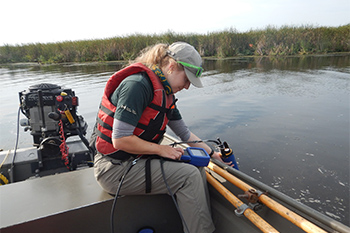
- Water Quality Monitoring
Marsh species require good water quality to thrive. To photosynthesize, aquatic plants require low turbidity, meaning that the water is clear enough for light to reach the plants. Invertebrates also rely on low turbidity, as well as good oxygen levels. Higher up the food chain, fish require enough nutrients in the water for food to be available, but not so many that they are unable to get enough oxygen. Some fish are visual predators, as are certain marsh birds, and require low turbidity to see their prey.
Water quality is an important indicator of ecosystem health. Since 2008, the park’s Resource Conservation team has been conducting annual water quality monitoring in the marsh as part of the Ecological Integrity Monitoring Program. Data is collected on various parameters such as turbidity, pH, dissolved oxygen levels, temperature, depth, and conductivity (measuring the ability of water to pass electrical current). Staff collect a portion of this data on the spot with a multi-parameter probe, while also collecting samples to be sent to a laboratory for analysis of additional factors such as phosphorus and nitrogen levels.
Monitoring water quality will be important to the marsh restoration project, as it will allow the team to monitor the effects of restoration activities on the health of the marsh. Keep your eyes peeled for team members collecting samples from a motor boat or canoe!
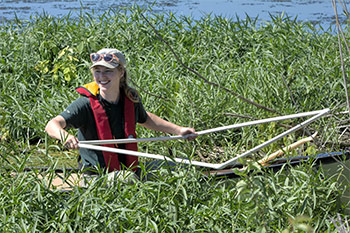
- American Water-willow Population Monitoring
The American water-willow is a provincially and federally threatened plant in Canada. Invasive species, erosion, and poor water quality are threats to this species so it is important to monitor the health of the population to ensure its continued presence in the park.
In 2020, Parks Canada staff conducted a detailed survey of the American Water-willow population in the marsh, and found patches of this species in Lake Pond, East Cranberry Pond, and the Northeast Channel. However, invasive Phragmites and cattails have been encroaching on many of the patches.
In continuing to monitor the American Water-willow population alongside management actions, we hope to see an increase in numbers and overall health of the plants. Roughly 400m2 of invasive Phragmites have been treated near American Water-willow.
Phase 3: Managing invasive cattail and Phragmites in water
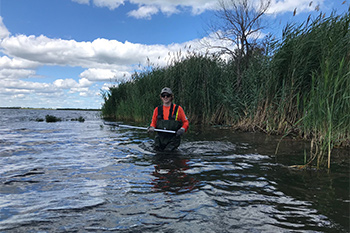
Following surveys and pre-management monitoring, staff will begin managing invasive cattails and Phragmites in the water. This includes cutting Phragmites under the water line, and creating channels and ponds in the cattail mat using two aquatic machines.
Preliminary cutting of targeted Phragmites patches began in 2020, and will continue throughout the project. The creation of channels and ponds will be done in 2021 and 2022.
As of July 2022, so far, staff at Point Pelee National Park have:
- removed 11,865 m2 of Phragmites using the cut-to-drown method,
- treated about 3,300 m2 of Phragmites on land with herbicide, and
- cut 900 m2 of invasive cattail mat into open water habitat using aquatic machinery.
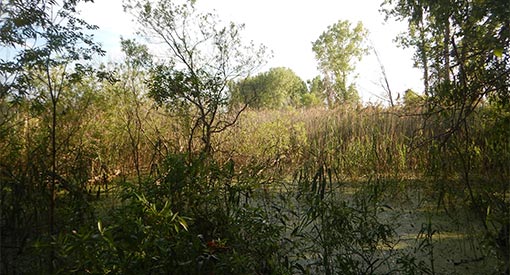
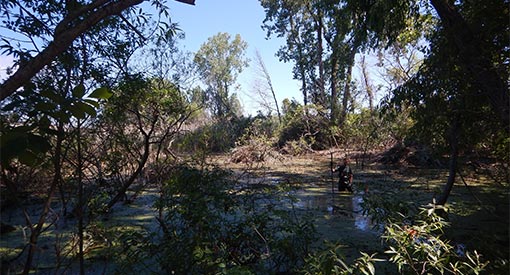
Above are two pictures of a management area in the marsh, side by side. The left image is before active management, and a tall, dense stand of invasive Phragmites can be seen in the background. The right image is after active management, and the Phragmites stand is gone, replaced by some piles of Phragmites, shoreline, and open water.
Phase 4: Applying herbicide to Phragmites on land
Late August into October is the best time for herbicide application when trying to control invasive Phragmites on dry land. Invasive Phragmites remain active late into the fall, when they shift their energy back to their root system, consequently transporting any herbicide applied at that time to the roots as well.
Targeted herbicide application began in the fall of 2020, where 2520 square metres of invasive Phragmites in the southeast corner of the marsh were treated with herbicide on land.
Phase 5: Burning Phragmites piles
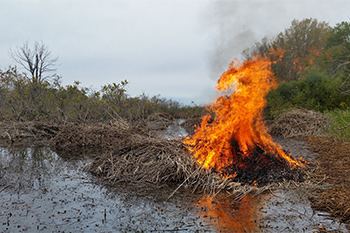
Though some of the piles created by the removal of Phragmites may be left as mounds to be used for hibernating, nesting, and basking, many will be removed from the marsh through prescribed burns when biomass is overly abundant (which could effect new growth or habitat use in the newly restored sites). These burns will be undertaken by trained staff once active management is complete for the year when environmental conditions are suitable to burning and while ensuring any wildlife within the piles can safely relocate.
As of July 2022, so far staff at Point Pelee National Park have burned 69 piles of invasive cattails and Phragmites when conditions were safe.
How will this affect visitors?
The battle against invasive species will not be won within the timeline of this project. However, this is a strong step in the right direction, one which will benefit wildlife and visitors alike for generations to come.
Where can you go to see marsh restoration?
- Shuster Trail: Looking North from the bridge, visitors can see the area where invasive Phragmites will continue to be managed both by cutting below the water line and herbicide application along the beach.
- Marsh boardwalk and tower: Creation of channels and ponds with aquatic machinery may be visible from these areas.
Taking on invasive species in a rare marsh habitat | Field Notes | Parks Canada
Get involved!
Monitoring species in the marsh is a big job. The more eyes and ears there are out there, the better! Visitors can upload their sightings to citizen science sites such as iNaturalist and eBird. These sightings will help us to gain a detailed understanding of both native and invasive species presence in the marsh.
- Date modified :